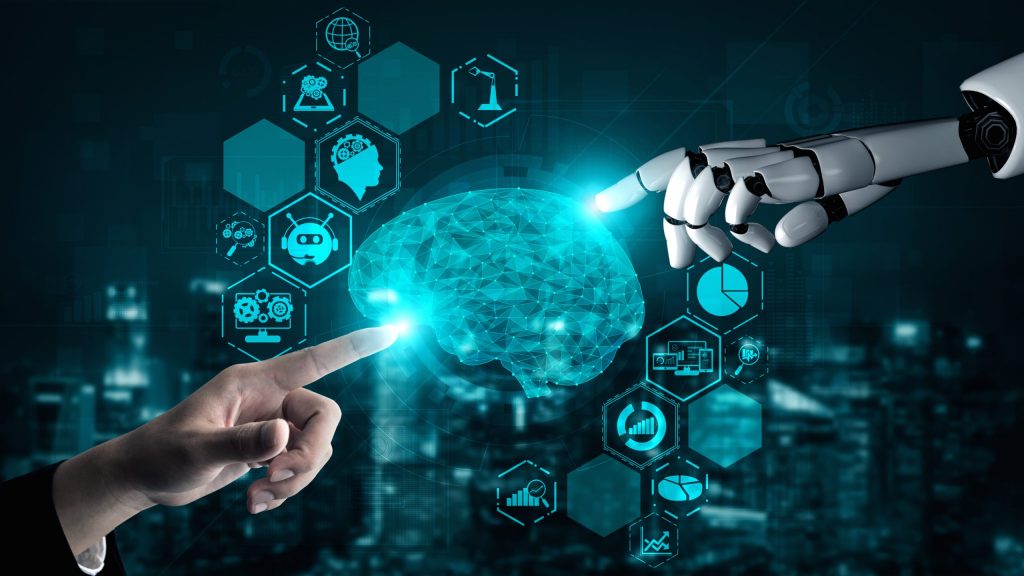The Role of Artificial Intelligence in L&D: Revolutionizing Training Delivery
Unleashing the Power of AI: Revolutionizing Training Delivery in Corporate Learning & Development
In today’s rapidly evolving business landscape, Learning and Development (L&D) professionals play a critical role in ensuring that employees have the necessary skills and knowledge to thrive. With the emergence of Artificial Intelligence (AI), training delivery has undergone a significant transformation. AI-powered corporate training and AI-enhanced training programs have revolutionized the way organizations approach employee learning and development. In this article, we will explore in-depth the specific role of AI in revolutionizing training delivery for Learning & Development Professionals. By harnessing the power of AI, we can unlock a range of unique benefits that drive better learning outcomes. Let’s delve into the remarkable impact of AI-powered corporate training and AI-enhanced programs in employee training.
Want to skip the article? Download our comprehensive free eBook on the impact of AI on Learning & Development.
Personalized Learning: Redefining Training with AI-Powered Corporate Training
AI-powered corporate training platforms leverage machine learning algorithms to analyze vast amounts of data, including employee demographics, learning preferences, and performance records. This analysis provides valuable insights into individual learning patterns, enabling the platforms to deliver tailored training programs. The platforms use AI algorithms to create personalized learning paths for employees, ensuring that the training materials are most relevant to their roles, preferences, and career aspirations.
Bridging Knowledge Gaps with AI: Personalized Training Modules for Enhanced Employee Engagement
By harnessing AI, organizations can identify specific knowledge gaps and provide targeted training content to bridge those gaps. For example, AI-powered platforms can assess employees’ existing skills and knowledge gaps and recommend specific training modules to address those gaps. They can also consider employees’ learning style preferences, such as visual, auditory, or kinesthetic, and deliver content accordingly. This level of personalization enhances engagement and motivation, as employees feel that their training experiences are designed specifically for their needs.
Accelerating Skill Development: Customized Learning Journeys with AI-powered Corporate Training
Furthermore, AI-powered platforms can track and analyze employee progress, providing insights into their strengths and weaknesses. This information allows L&D professionals to tailor future training interventions to focus on areas where individuals require more support. By catering to individual strengths, weaknesses, and learning styles, AI-powered platforms enhance engagement and motivation, resulting in improved learning experiences and accelerated skill development. With AI-powered corporate training, organizations can provide a customized learning journey for each employee, fostering a sense of ownership and empowering individuals to take control of their development.
Adaptive Training for Success: How AI-Enhanced Programs Transform Employee Learning
AI-enhanced training programs take personalization a step further by adapting to the learner’s progress in real-time. These programs analyze data on employee performance, learning pace, and skill gaps to dynamically adjust content delivery. By continuously monitoring employees’ learning journey, AI algorithms identify areas where learners require additional support or content adjustments, enabling organizations to optimize training programs.
Adaptive training programs utilize AI to create personalized learning experiences based on each employee’s needs and progress. For instance, if an employee struggles with a specific topic, the AI system can provide additional resources, such as explanatory videos, interactive quizzes, or supplementary reading materials, to reinforce understanding. On the other hand, if an employee demonstrates advanced proficiency, the AI system can adapt the training content to provide more challenging materials or suggest advanced courses to foster continued growth.
This adaptability empowers individuals to learn at their own pace, leading to better knowledge retention and improved performance. AI-powered adaptive training programs promote a growth mindset among employees, encouraging continuous learning and development. Employees can receive targeted support and guidance, ensuring that their training experiences are tailored to their unique needs.
To learn more about the latest trends in learning & development strategy, make sure to download a free copy of our eBook on modern L&D strategy by Nick van Dam.
Enhancing Engagement and Motivation: The Impact of AI in Corporate Training
Traditional training methods often struggle to captivate employees’ attention and maintain their motivation throughout the learning process. AI-powered platforms tackle this challenge by incorporating interactive elements, such as simulations, gamification, and multimedia content. These engaging and immersive learning experiences leverage AI to create realistic scenarios, enabling employees to apply knowledge in practical contexts.
AI-powered simulations provide employees with a safe and controlled environment to practice their skills. They can simulate real-life business situations, allowing employees to make decisions and witness the consequences in a risk-free environment. For example, sales representatives can engage in virtual sales presentations with AI-generated virtual clients, honing their communication and negotiation skills. These simulations provide valuable opportunities for employees to apply their learning in realistic scenarios, building confidence and competence.
Boosting Engagement and Motivation: Gamified AI Training Programs Transform the Learning Experience
In addition to simulations, gamification elements are incorporated into AI-powered training programs to enhance engagement and motivation. Leaderboards, badges, and rewards create a sense of competition and achievement, encouraging employees to actively participate and strive for improvement. For example, employees can earn badges or points for completing training modules or achieving specific learning milestones. This gamified approach transforms the learning experience into a more interactive and enjoyable process, increasing employee motivation and commitment to their training journey.
Enhancing Learning Effectiveness: AI-Powered Platforms Deliver Multimedia Content for Diverse Learning Styles
Moreover, AI-powered platforms leverage multimedia content to cater to different learning preferences and styles. They can deliver information through a variety of formats, such as videos, audio clips, interactive quizzes, and infographics. This multi-modal approach ensures that employees receive information in a format that resonates with them, increasing their understanding and retention of the material. For example, visual learners can benefit from explanatory videos, while auditory learners may prefer audio-based content. By accommodating diverse learning preferences, AI-powered platforms foster an inclusive and effective learning environment.
Continuous Learning and Performance Improvement: Leveraging AI Analytics
One of the key advantages of AI in training delivery is its ability to provide data-driven insights for continuous learning and performance improvement. AI-powered platforms collect and analyze vast amounts of data on employee performance, training outcomes, and learning behaviors. This data can be used to identify trends, patterns, and areas for improvement.
By leveraging AI analytics, L&D professionals gain valuable insights into the effectiveness of training programs. They can identify which modules or learning materials yield the best results and make data-informed decisions to optimize training content. For example, if certain topics consistently receive low engagement or poor performance, adjustments can be made to improve the content delivery or modify the training approach.
Furthermore, AI analytics enable L&D professionals to track individual and organizational progress over time. They can identify skill gaps that require attention and develop targeted interventions to address them. These insights facilitate a proactive approach to learning and development, ensuring that training efforts align with business objectives and contribute to overall performance improvement.
For more information on how to measure the ROI of your learning & development activities, listen to our free podcast “Does your Learning Make an Impact?” by the Head of Learning Measurement at Facebook.
Embracing AI in L&D: Unlocking the Potential of Employee Development and Organizational Success
Artificial Intelligence has revolutionized training delivery in corporate Learning & Development. AI-powered corporate training and AI-enhanced programs have brought forth personalized learning experiences, adaptive training, enhanced engagement, and data-driven insights. By harnessing AI, organizations can create customized learning paths, adapt content to individual needs, and deliver engaging and immersive training experiences. Moreover, AI analytics provide L&D professionals with valuable data to continuously improve training programs and drive performance improvement.
As Learning & Development professionals, embracing AI in training delivery can unlock the full potential of employees and drive organizational success. By incorporating AI-powered platforms and programs into their strategies, L&D professionals can create a future-ready workforce that thrives in the fast-paced, ever-evolving business landscape.
The role of AI in L&D is not just a technological advancement; it is a catalyst for transformative learning experiences and continuous improvement. By embracing AI, organizations can revolutionize their approach to training delivery, empowering employees to acquire new skills, adapt to change, and contribute to their fullest potential. The possibilities are immense, and the benefits are tangible. It’s time to embrace AI in L&D and embark on a new era of employee development and organizational success.
To learn more about the enormous potential that AI has for learning & development make sure to download our free eBook here.

Download free L&D content

Free eBook: Blended Learning
Blended Learning. Solved in one solution. Get the right blend of modern and traditional learning. Why Blended Learning is important? What works for one employee
Modern L&D Strategy by Nick van Dam
Download a free copy of our best-selling eBook with the newest trends in Learning & Development strategy by the former Global Chief Learning Officer at McKinsey & Co.

Free Learning & Development content

Optimizing L&D for Hybrid Workforces: Best Practices and Success Stories
In the contemporary corporate world, the emergence of hybrid workforces has heralded a significant paradigm shift in how organizations operate. For Learning and Development (L&D), this shift brings about unique challenges and opportunities. This article is your guide to navigating the complexities of hybrid workforces, offering comprehensive insights, practical tips, and inspiring success stories.

10 Strategies for Improving Learning Engagement and Motivating Learners
How can you keep your learners engaged and motivated? Whether you’re working in corporate training or as an educator, it’s important to have effective learning engagement strategies in place. By utilizing the right tools and techniques, you can enhance the learning experience and make your training more successful.

How to maximize employee engagement in L&D while minimizing costs
mployee engagement in learning and development (L&D) programs is crucial for the success of any organization. Engaged employees are more productive, more motivated, and more likely to stay with the company. However, with tight budgets and limited resources, it can be challenging for organizations to create L&D programs that engage employees while minimizing costs. In this article, we explore strategies for maximizing employee engagement in L&D programs while minimizing costs.



